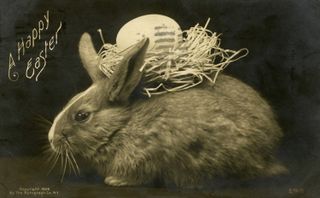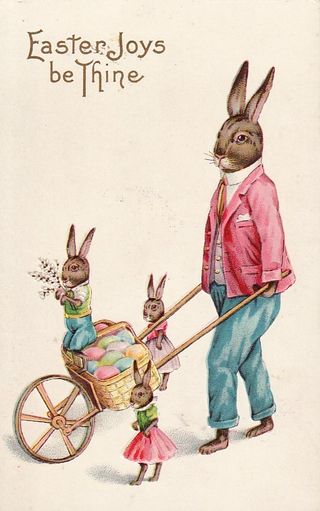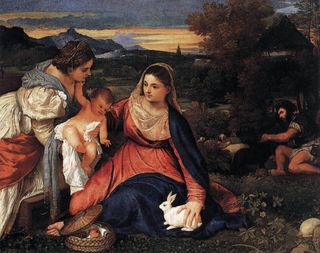Where Did the Easter Bunny Come From? Ask This Dead German Scientist

Depending on the age of the observer, Easter either celebrates the miracle of the resurrection of Jesus Christ, or the miracle of a bipedal rabbit hatching and hiding a litter of chocolate eggs in the nooks and crannies of your home.
Where did the Easter Bunny come from, and how did the floppy-eared animal get his fuzzy tail wrapped up in one of Christianity's holiest days? Egg-bearing rabbits, as you can imagine, appear nowhere in the New Testament. But they do — weirdly enough — appear in scientific literature.
You can see the first recorded mention of the Easter Bunny in a collection of medical essays published in Germany in 1682. According to The Royal Society, one of the odder essays in this collection is a 16-page dissertation on Easter eggs, written by a young German doctor and theology buff named Johannes Richier. [Easter Science: 5 Odd Facts About Eggs]
In his dissertation, Richier described a regional character from western Germany called the "Osterhase" — aka the "Easter hare" — who was said to hatch and hide multicolored eggs for children (and gullible adults) to discover around their homes and gardens on Easter Sunday.
Being a good physician, Richier only wrote about the Easter hare and his psychedelic eggs to issue a health warning. "The young people often lose their health with these Easter eggs," Richier wrote in a passage translated by The Royal Society, "because they avidly swallow up the eggs without salt, butter or any other flavoring," resulting in nasty tummy aches. (Chocolate coating has since solved this problem.)
Despite Richier's finger-wagging, the Easter hare's star continued to rise and, according to History.com, soon crossed the Atlantic Ocean with German settlers bound for Pennsylvania. As the delightful legend spread, eager children built cozy nests to court the egg-hatching hare; eventually, the hare became a bunny (yes, they are different species) and the nests evolved into the forebears of our modern-day Easter baskets.

OK, but why does the bunny lay eggs?
It's hard to track the Easter Bunny's history before Richier's first mention, and even harder to figure out why children were so ready to believe in a mythical egg-laying hare. But some historians attribute the rise of egg-and-rabbit imagery on Easter to the holiday's roots in springtime fertility celebrations.
Sign up for the Live Science daily newsletter now
Get the world’s most fascinating discoveries delivered straight to your inbox.
Like many holidays, Easter coincides with a changing of the seasons. Though the exact date changes year to year, Easter always falls near the Northern Hemisphere's vernal equinox — the day that marks the beginning of spring and the start of six glorious months when the daylight outlasts the night. In the increasingly warm and sunny months that follow, plants bloom, animals emerge from hibernation and lots of celebratory reproduction occurs. According to some scholars, Easter actually took its name from a pagan spring festival called Ostara, thrown every year to honor a goddess of fertility.
Eggs have been a symbol of fertility for thousands of years, and have been decorated at Easter at least since medieval times, according to Brent Landau, a religious studies scholar at the University of Texas at Austin. Their status as a symbol of new life (and, hence, the resurrection of Jesus) is easily understood.

Hares, too, are celebrated for their prolific breeding — sometimes for the wrong reasons. Back in ancient Greece, for example, writers like Pliny and Plutarch were convinced that hares were hermaphrodites, capable of switching their gender month-by-month. (They're not.)
One reproductive behavior that does make hares remarkable is a phenomenon called superfetation — meaning mothers can conceive a second litter of offspring while still pregnant with their first. Of course, this has been misunderstood, too. According to nature writer Rob Cowen, hares were once believed to be capable of self-impregnation, giving them an unusual association with virgin birth. You can see this reflected in art beginning around the time of the Renaissance, when rabbits and hares started appearing as common symbols of fertility and purity in religious paintings (see "The Madonna of the Rabbit" by Titian, for example).
Whether you choose to see the Easter Bunny as a symbol of purity, fertility or merely a harbinger of chocolate, we hope you have a happy Easter, if you celebrate, and remember the sage words of Johannes Richier: Don't swallow too many rabbit eggs without salt or butter.
Originally published on Live Science.

Brandon is the space/physics editor at Live Science. His writing has appeared in The Washington Post, Reader's Digest, CBS.com, the Richard Dawkins Foundation website and other outlets. He holds a bachelor's degree in creative writing from the University of Arizona, with minors in journalism and media arts. He enjoys writing most about space, geoscience and the mysteries of the universe.

